Finding and Correcting Text
3 4
Visio can correct spelling or find and replace all uses of particular words. You can specify whether you want Visio to search a selection, a page, or the whole diagram. When you search for or check the spelling of text, Visio searches in all shapes, including
- Text-only shapes
- Data fields
- Stencils
- Custom property fields
- Text you enter in the Properties dialog box
Tip
To search for shapes, select File, Find Shapes to open the Find Shape pane. You can locate shapes by using names or keywords. For details, see "Finding the Shape You Want."
Finding and Replacing Text
Finding and replacing text in a Visio diagram works a little differently from your typical word processing document. When Visio searches for text, it examines text in shapes, in text-only shapes, on stencils, in the Properties box, and in data files. In addition, with this release Visio can now search for text within custom properties, shape names, and user-defined cells (a type of ShapeSheet cell of interest to shape developers). You can also search for special characters, such as tabs or line breaks.
When you search for a word or phrase in Visio using the Find or Replace command, you can define the scope of the search—selected text only, one page, or all pages in the diagram. Visio searches the text blocks of shapes for the text you specify. When you use the Find command, you can refine the search even more. Table 4-6 shows you the options for searching when you use the Find command.
Table 4-6. Options for Searching
| Search Location | Description |
|---|---|
Selection | Searches for text only in the currently selected shapes on the drawing page. |
Current Page | Searches for text on the current page only. |
All Pages | Searches for text on all pages of your diagram. |
Shape Text | Searches the text blocks of all shapes, including text- only shapes. |
Custom Property | Searches for text in the custom property fields of all shapes. |
Shape Name | Searches the Name field of a master shape or instance of a master shape (that is, what you drop on the page). This option is best used when a stencil file is open for editing to check master shape names. |
User-Defined Cell | Searches the formula text in the Value and Prompt cells of the User-Defined Cells section of the ShapeSheet spread-sheet for all shapes. |
To search for a word or phrase, follow these steps:
- Choose Edit, Find; or press Ctrl+F to open the Find dialog box.
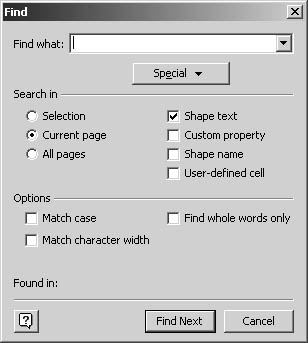
- In the Find What box, type the word or phrase you want to search for. To search for a special character, click the Special button, and then select an option.
- Under Search In, choose the options you want to control where Visio searches.
- Under Options, select the matching options you want, and then click Find Next.
If Visio locates an occurrence of the search text in a shape, the text is highlighted in the diagram. If the search text is found in a shape name or user-defined cell, the name is displayed in the Found In section of the Find dialog box.
- To edit the found text, click the Close or Cancel button to close the Find dialog box. Or click Find Next to find its next occurrence.
To replace a word or phrase, follow these steps:
- Choose Edit, Replace to open the Replace dialog box.
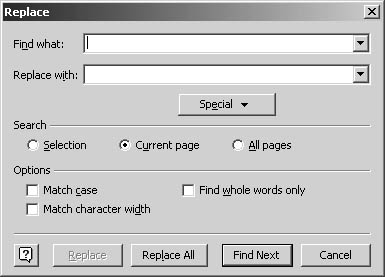
- In the Find What box, type the word or phrase you want to replace. To search for a special character, click the Special button, and then select an option.
- In the Replace With box, type the new word or phrase you want to use. To replace the Find What text with a special character, click the Special button, and then select an option.
- Under Search, select an option to control where Visio searches.
- Under Options, select the match options you want.
- To replace all instances of the Find What word or phrase, click Replace All. Otherwise, click Find Next to search for the next occurrence of the text.
If Visio locates an occurrence of the search text in a shape, the text is highlighted in the diagram.
- Click Replace to replace the selection with the text in the Replace With box, and then click Find Next.
Visio displays a message when it has finished searching.

- Click OK, and then click the Close button to close the Replace dialog box.
The commands on the Edit menu aren't the only commands for searching. Like other Microsoft Office programs, Visio includes a task pane for searching in other files on your computer or elsewhere, as well as the Find Shapes command for tracking down elusive shapes. Table 4-7 summarizes the commands you can use to search for text, files, or shapes.
Table 4-7. Commands for Searching in Visio and Beyond
| Command | Description |
|---|---|
Edit, Find | Searches for a word or phrase in a diagram. |
Edit, Replace | Searches for a word or phrase in a diagram and then replaces it with a new word or phrase. |
View, Task Pane | Opens the Basic Search pane, where you can search for text in other files, including Microsoft Office documents, on your computer, in network folders, or in Microsoft Outlook. For details, see "Searching for a File to Open." |
File, Find Shape | Opens the Find Shape pane, which you can use to locate shapes. For details, see "Finding the Shape You Want." |
Checking Spelling
When you check spelling in a diagram, Visio examines the spelling of text in shapes, including text-only shapes, and data fields. Visio typically checks the spelling for shapes on the current page only, but you can specify to check selected text only or all pages in a diagram.
Follow these steps to check spelling in a drawing:
- Choose Tools, Spelling, or press F7.
If Visio encounters any words not found in its dictionary, it displays the Spelling dialog box.
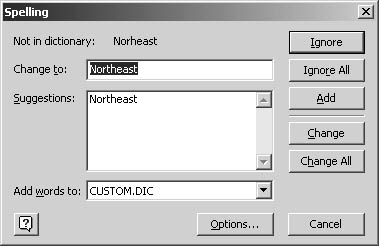
- If the highlighted suggestion in the Change To box is correct, click the Change button to replace the misspelled word with this text. Or click the Change All button to replace every instance of the misspelled word throughout the drawing file. Otherwise, choose a word in the Suggestions box, or type the correct spelling in the Change To box, and then click Change.
- If the unrecognized word is spelled correctly, click Ignore to continue the check. Or click Ignore All to ignore all instances of the word in the diagram and continue the check.
- If you want to add an unrecognized word to Visio's spelling dictionary, click the Add button.
For example, use the Add button to add your company's name to the dictionary so the spelling checker won't ask you about it every time.
- Click Options to ensure that the spelling options are set the way you want.
When Visio has finished checking spelling (or if it doesn't find any misspelled words), a message box appears indicating that it has finished checking.
- Click OK.
Tip
To set the scope of the spelling checker—selected text, text on a page, or text on all pages—choose Tools, Options, and then click the Spelling tab. Under Search, specify the option you want to use by default every time you check spelling in a diagram.
Creating Your Own Dictionary
When you check spelling in a diagram, Visio compares words to its dictionary, a file called custom.dic. You can add words to this dictionary as you check spelling, but for some diagrams with unusual or industry-specific terms, you might not want to pollute the built-in dictionary. For your personal vocabulary needs, Visio lets you create a user dictionary for storing words that you want the spelling checker to recognize. When the spelling checker encounters an unrecognized word you can add it to your user diction-ary so that it won't be listed as a misspelling in the future.
Visio uses the active dictionary to check spelling. When you create a user dictionary, you add it to the list of active dictionaries. More than one dictionary can be active. Then, when you use the Spelling command, all the active dictionaries, including the user dictionary, appear in the Add Words To box. When you no longer want your user dictionary to appear in this box, you can remove it from the active list. Removing a dictionary doesn't delete it; it just prevents the dictionary from showing up in the Spelling dialog box, so you can't add words to it.
Note
Visio saves dictionaries in the C:\Documents and Settings\<user>\Application Data\Microsoft\Proof folder or C:\Programs\Common\Proof folder.
Follow these steps to create a user dictionary and make it active:
- Choose Tools, Options, and then click the Spelling tab.
- Click the Add button next to the Custom Dictionaries box.
The Add User Dictionary dialog box appears.
- In the File Name box, type a name for the dictionary, and then click Open.
In the Options dialog box, the dictionary name you created appears in the Custom Dictionaries box.
- Click OK to close the Options dialog box.
The user dictionary has been added to the diagram.
Follow these steps to add words to a user dictionary:
- Choose Tools, Spelling.
- When Visio encounters a word it doesn't recognize, click the Add Words To drop-down arrow, and then select the name of your user dictionary.
- Click the Add button to add the word to the user dictionary.
To make a user dictionary inactive
- Choose Tools, Options, and then click the Spelling tab.
- In the Custom Dictionaries box, select the name of your user dictionary, and then click Remove.
Visio removes the user dictionary from the list. The dictionary file is not deleted.
- Click OK.
Tip
To reactivate an existing user dictionary, click Add on the Spelling tab of the Options dialog box, locate the user dictionary in the Add User Dictionary dialog box, and then click Open.
Turning Off the Spelling Checker
Visio automatically checks your spelling as you type and displays a wavy, red underline under words that it doesn't recognize. Some people love an interactive spelling checker, and others loathe the interruption. If you're in the latter camp, you can turn off the spelling checker. That way, you can control when you want Visio to check your spelling—just press F7.
Turn off the automatic spelling checker as follows:
- Choose Tools, Options, and click the Spelling tab.
- Clear the Check Spelling As You Type check box, and then click OK.
Automatically Correcting Text as You Type
It used to be only the shapes were smart in Visio. Now text is smart, too, with automatic corrections. Visio 2002 includes many of the AutoCorrect and AutoFormat features that make Microsoft Word so nice for typing. Depending on the options you choose, Visio can automatically correct common typos and capitalization errors and format certain characters as you type. For example, if you start a new sentence with a lowercase letter, Visio can automatically replace it with an uppercase letter.
Visio can correct the following typos and formats:
- Capitalization mistakes. When you type too many capital letters in a word, or too few at the start of a sentence or in the name of a day, Visio fixes the word. For example, VIsio becomes Visio and tuesday becomes Tuesday.
- Caps Lock errors. When you accidentally press the Caps Lock key on your keyboard while typing, Visio continues to type in lowercase.
- Formatting fixes. Visio swaps symbol characters for commonly typed letters. For example, some fractions (3/4) are converted to stacked fraction characters (¾), and two hyphens (- -) become an em-dash (—).
What if AutoCorrect "fixes" a word that you typed exactly as intended? When AutoCorrect makes a correction that you don't want, you can press Ctrl+Z (or choose Edit, Undo) to undo the correction.
Both of these techniques can be an irritating interruption. You can instead define exceptions to the rules, so that AutoCorrect applies its capitalization rules only to the words you want. Or you can disable the feature altogether and trust the spelling checker to catch your mistakes.
Follow these steps to specify the AutoCorrect options you want:
- Choose Tools, AutoCorrect Options.
The AutoCorrect dialog box appears and displays the AutoCorrect tab.
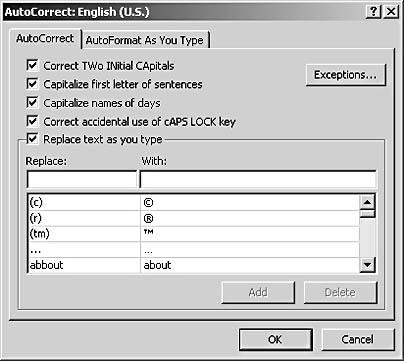
- To set capitalization corrections, select or clear the first four check boxes in the dialog box.
- To set formatting options, click the AutoFormat As You Type tab.

- Select or clear the options you want, and then click OK.
Note
To disable AutoCorrect altogether, clear all of the check boxes in the AutoCorrect dialog box.
Adding AutoCorrect Entries
If the list of built-in AutoCorrect entries doesn't contain the corrections that you want, you can easily add or edit AutoCorrect entries. For example, you can add an entry to automatically spell out the name of your company when you type an abbreviation.
Follow these steps to add an AutoCorrect entry:
- Choose Tools, AutoCorrect Options.
The AutoCorrect dialog box appears and displays the AutoCorrect tab.
- Make sure Replace Text As You Type is checked.
- In the Replace box, type a word or phrase that you often mistype or misspell, or type the short form of a word that you want AutoCorrect to spell out.
For example, type MS Press.
- In the With box, type the correct spelling of the word.
For example, type Microsoft Press.
- Click Add. Continue adding entries, or click OK to close the AutoCorrect dialog box.
Specifying Exceptions to the AutoCorrect Rules
You can prevent AutoCorrect from making specific capitalization corrections. When you define an AutoCorrect exception, you specify letters that should not be capitalized. Defining an exception lets you keep the AutoCorrect feature enabled and yet avoid the irritation of undoing unwanted corrections. Otherwise, when AutoCorrect makes an unwanted correction, you must press Ctrl+Z (or choose Edit, Undo) to remove the entire correction and retype the word you want.
Follow these steps to define a capitalization exception:
- Select Tools, AutoCorrect Options, and then click the Exceptions button.
The AutoCorrect Exceptions dialog box appears with the First Letter tab displayed.
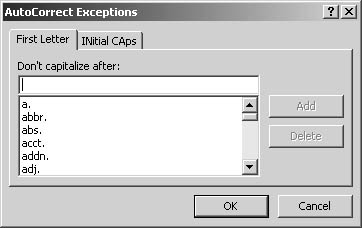
- To prevent AutoCorrect from capitalizing a word you type after a specific abbreviation, type the abbreviation (including periods) in the Don't Capitalize After box. Click Add.
- To prevent AutoCorrect from correcting a word that contains mixed uppercase and lowercase letters, click the INitial CAps tab. In the Don't Correct box, type the word, and then click Add. Click OK to return to the AutoCorrect dialog box.
EAN: 2147483647
Pages: 211